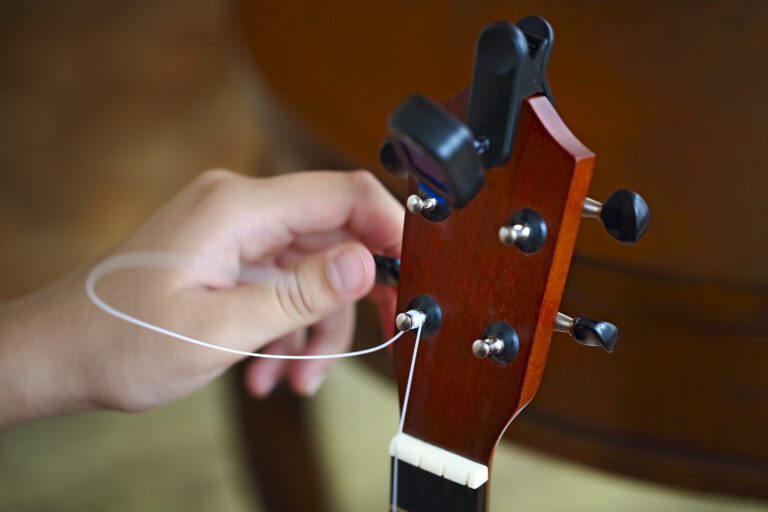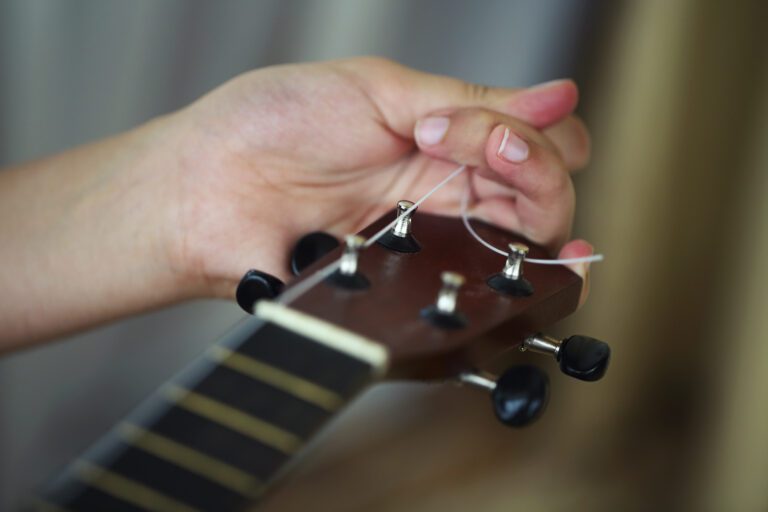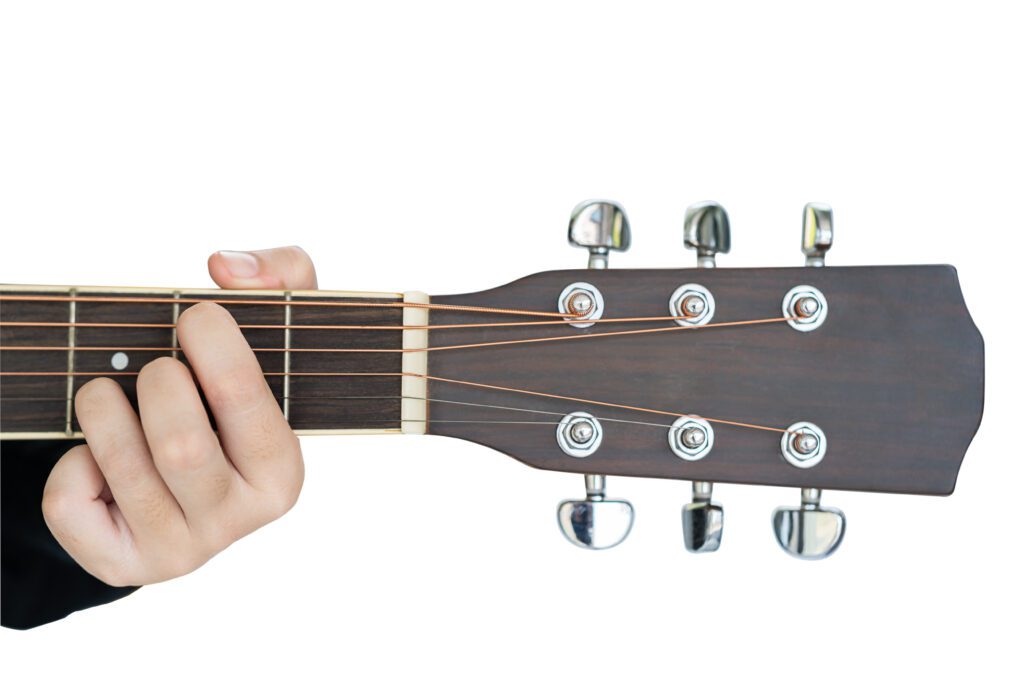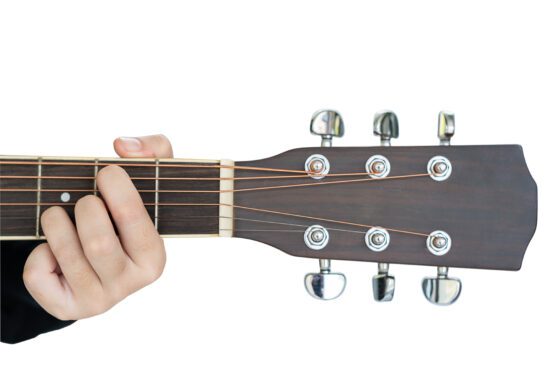How to Tune an Acoustic Guitar by Ear
Learning to tune acoustic guitar by ear is a timeless skill every guitarist should master. While digital tuners and apps are convenient, there may be times when one isn’t available. Tuning by ear sharpens your listening skills, improves pitch recognition, and deepens your connection to the instrument. It also helps you notice subtle tuning issues as you play.
This guide is perfect for beginners who want to:
- Develop better ear training
- Understand string relationships
- Learn traditional guitar tuning skills
Let’s dive in!
🎼 Standard Guitar Tuning Overview

A standard-tuned acoustic guitar (from thickest to thinnest string) is tuned to:
E – A – D – G – B – E
String Numbers:
6th String: Low E (thickest)
5th String: A
4th String: D
3rd String: G
2nd String: B
1st String: High E (thinnest)You’ll tune one string (reference) and use it to tune the others by matching pitches.
👂 Step-by-Step: Tuning by Ear

Step 1: Tune the 6th String (Low E) to a Reference Note
Use a reference pitch to get your 6th string close to standard tuning. You can:
- Use a piano, keyboard, or another tuned instrument
- Listen to an online reference note (search “Low E string guitar tone”)
- Use your vocal pitch if you’ve memorized the E sound🎧 Once your 6th string is in tune, you’ll use it to tune the others.
Step 2: Tune the 5th String (A) Using the 5th Fret Method

Press the 5th fret on the 6th string (it should sound like an open A string)
Tune the open 5th string to match that sound
Go back and forth until the pitches sound identical
🎯 Tip: Listen for beats (a wobbling or pulsing sound). The fewer the beats, the closer you are to perfect tuning.
Step 3: Tune the 4th String (D)
Press the 5th fret on the 5th string—this should match the open 4th string
Tune the 4th string until the two notes sound the same
Repeat the listen-match-adjust process.
Step 4: Tune the 3rd String (G)

Press the 5th fret on the 4th string
Match it to the open 3rd string (G)
Use smooth turning on the tuning pegs and small adjustments.
Step 5: Tune the 2nd String (B) – (This One Is Different!)
Here’s where it changes:
Press the 4th fret on the 3rd string (G)—this should match the open 2nd string (B)
Tune your 2nd string to match this tone
📌 Remember: This is the only pair not tuned using the 5th fret.
Step 6: Tune the 1st String (High E)

Press the 5th fret on the 2nd string (B)
Match it to the open 1st string (high E)
Once done, play all open strings and listen if they feel balanced. You can now fine-tune each if necessary.
🧏♂️ Tuning Tips for Better Accuracy
how to tune your acoustic guitar by ear is a skill every serious guitarist should have. It sharpens your hearing, deepens your musical understanding, and ensures you’re never stuck without a tuner again.
It may take some practice at first—but the payoff is long-term musical independence.
Here are a few tips to help you get it right:
Use harmonics (for advanced players) to match overtones.
Always tune up to the pitch, not down—this keeps strings more stable.
Mute nearby strings while tuning to reduce confusion.
Practice tuning regularly—it trains your ear faster than you think!
Play simple chords (like G or E minor) after tuning to double-check your results.
🎶 Tune your strings, trust your ears, and enjoy the music!
🎓 At The Mystic Keys – We Teach Guitar the Right Way

At The Mystic Keys, we help you grow as a musician from the ground up—including fundamentals like tuning, technique, and rhythm.
🎸 Our one-on-one online Zoom lessons include:
- Guitar for beginners and advanced students
- Acoustic and electric guitar techniques
- Personalized session notes and recordings
- Experienced, Grade 8-certified teachers
- Flexible scheduling with Trinity-based certification prep
We don’t just teach songs—we build confident, independent musicians.
✅ Conclusion: Master Your Ear, Master Your Guitar
Learning to tune acoustic guitar by ear is more than just a backup plan—it’s a valuable skill every serious guitarist should master. It sharpens your ear, deepens your musical understanding, and gives you full control, even without a tuner.
It might take some practice, but the result is true musical independence.
🎶 Tune your strings, trust your ears, and enjoy the music!
Related Blogs
Music Theory Guide For Beginner’s
This Music Theory Guide is perfect for beginners who want to understand how music works—from notes and scales to chords and rhythm. It lays a strong foundation that helps musicians of all levels gain clarity and confidence in their playing, composing, or singing.
The Best Way to Train Your Ear for Music
A well-trained ear is one of the most valuable tools any musician can have. Whether you’re a singer, instrumentalist, producer, or composer, your ability to recognize pitch, rhythm, harmony, and melody will significantly enhance your creativity and confidence.
The voice is an incredible gift. It’s how we sing, teach, inspire, and connect. But like any instrument, it needs proper care to remain strong, clear, and resilient. Vocal strain is a common challenge faced not only by singers, but also by teachers, speakers, coaches, content creators—anyone who relies on their voice daily.








